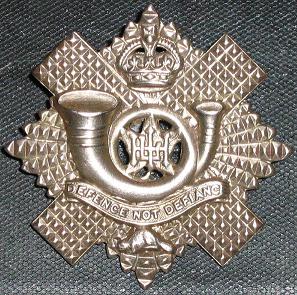Highland Light Infantry of Canada facts for kids
Quick facts for kids The Highland Light Infantry of Canada  |
|
|---|---|
| Active | 1886–1954, 1957–1965 |
| Country | |
| Branch | Canadian Militia (1886-1940) Canadian Army (1940-1954, 1957-1965) |
| Type | Light Infantry |
| Role | Infantry |
| Size | One battalion |
| Part of | Non-Permanent Active Militia (1886-1940) Royal Canadian Infantry Corps (1942-1954, 1957-1965) |
| Garrison/HQ | Galt, Ontario |
| Motto(s) | Defence Not Defiance |
| Colors | Facing colour buff |
| March | Quick – Band: "Whistle o'er the Lave o't” Quick – Pipes: "Sean Triubhas" |
| Engagements | First World War Second World War |
| Battle honours | See #Battle Honours |
| Commanders | |
| Notable commanders |
Harry Wickwire Foster |
| Insignia | |
| Tartan | MacKenzie |
The Highland Light Infantry of Canada was an infantry regiment (a military unit) in the Canadian Army. It existed for many years, helping to defend Canada. In 1965, this regiment joined with another one, called The Scots Fusiliers of Canada. Together, they formed a new unit known as The Highland Fusiliers of Canada. Today, this unit is called The Royal Highland Fusiliers of Canada.
Contents
A Brief History of the Regiment
How the Regiment Started
The Highland Light Infantry of Canada began on September 14, 1866. It was first known as the 29th Waterloo Battalion of Infantry. This happened in a place called Berlin, Ontario, which is now Kitchener, Ontario.
At first, the unit was made up of five smaller groups of soldiers. These groups were located in different towns in the Waterloo County area. The main office for the regiment was in Berlin.
Changes Over the Years
Over time, the regiment's name changed several times.
- In 1900, it became the 29th Waterloo Regiment.
- In 1912, its main office moved to Galt, Ontario.
- In 1915, it was renamed the 29th Regiment (Highland Light Infantry of Canada). This is when the "Highland Light Infantry" part was added.
- In 1920, it officially became The Highland Light Infantry of Canada.
Serving in the First World War
When the First World War started in 1914, the 29th Waterloo Regiment did not go overseas right away. However, many of its soldiers joined other Canadian units that were sent to fight. They helped form the 1st Battalion (Ontario Regiment), CEF.
Two other battalions (large groups of soldiers) were also formed. These were the 34th Battalion, CEF and the 111th Battalion (South Waterloo), CEF. Many soldiers from the 29th Regiment joined these units. These battalions helped send new soldiers to the main Canadian forces fighting overseas.
The Second World War
During the Second World War, The Highland Light Infantry of Canada played a very important role.
- On May 24, 1940, the regiment created a special unit for active service. This unit was called The Highland Light Infantry of Canada, CASF.
- On July 20, 1941, this unit traveled to Great Britain.
- On D-Day, June 6, 1944, the soldiers landed in Normandy, France. They were part of the 9th Canadian Infantry Brigade and the 3rd Canadian Infantry Division.
- The regiment fought bravely across North-West Europe until the war ended.
- After the war, some soldiers also served in Germany as part of the Canadian Army Occupation Force.
After the Wars
After the Second World War, there were more changes for the regiment.
- In 1954, it briefly joined with another regiment, The Perth Regiment. They became The Perth and Waterloo Regiment.
- But in 1957, they separated again and went back to being The Highland Light Infantry of Canada.
- Finally, on February 26, 1965, the regiment joined with The Scots Fusiliers of Canada. This created the new unit called The Highland Fusiliers of Canada. This is the unit that eventually became The Royal Highland Fusiliers of Canada.
Regimental Uniforms
The soldiers of the Highland Light Infantry of Canada wore special uniforms.
- Initially, they wore a green Glengarry (a type of hat), trews (tartan trousers), and a scarlet jacket.
- In 1935, they started wearing kilts, which are traditional Scottish skirts.
- The pipers (musicians who play bagpipes) and band members had even more unique uniforms. They wore a feather bonnet (a tall hat with feathers), a red hackle (a feather plume), and a black sporran (a pouch worn with a kilt). Their socks, called hose, had a special MacKenzie pattern.
Battle Honours
Battle honours are special awards given to military units for their bravery and success in battles. The Highland Light Infantry of Canada earned many honours for its service in both World Wars.
First World War Honours
- Mount Sorrel
- Somme, 1916
- Arras, 1917, '18
- Hill 70
- Ypres, 1917
- Amiens
- Hindenburg Line
- Pursuit to Mons
Second World War Honours
- Normandy Landing
- Caen
- The Orne (Buron)
- Bourguébus Ridge
- Faubourg de Vaucelles
- Falaise
- The Laison
- Chambois
- Boulogne, 1944
- Calais, 1944
- The Scheldt
- Savojaards Platt
- Breskens Pocket
- The Rhineland
- Waal Flats
- The Hochwald
- The Rhine
- Zutphen
- Leer
- North-West Europe, 1944-1945
See also
- Canadian-Scottish regiment
- The Royal Highland Fusiliers of Canada
- Highland Light Infantry


